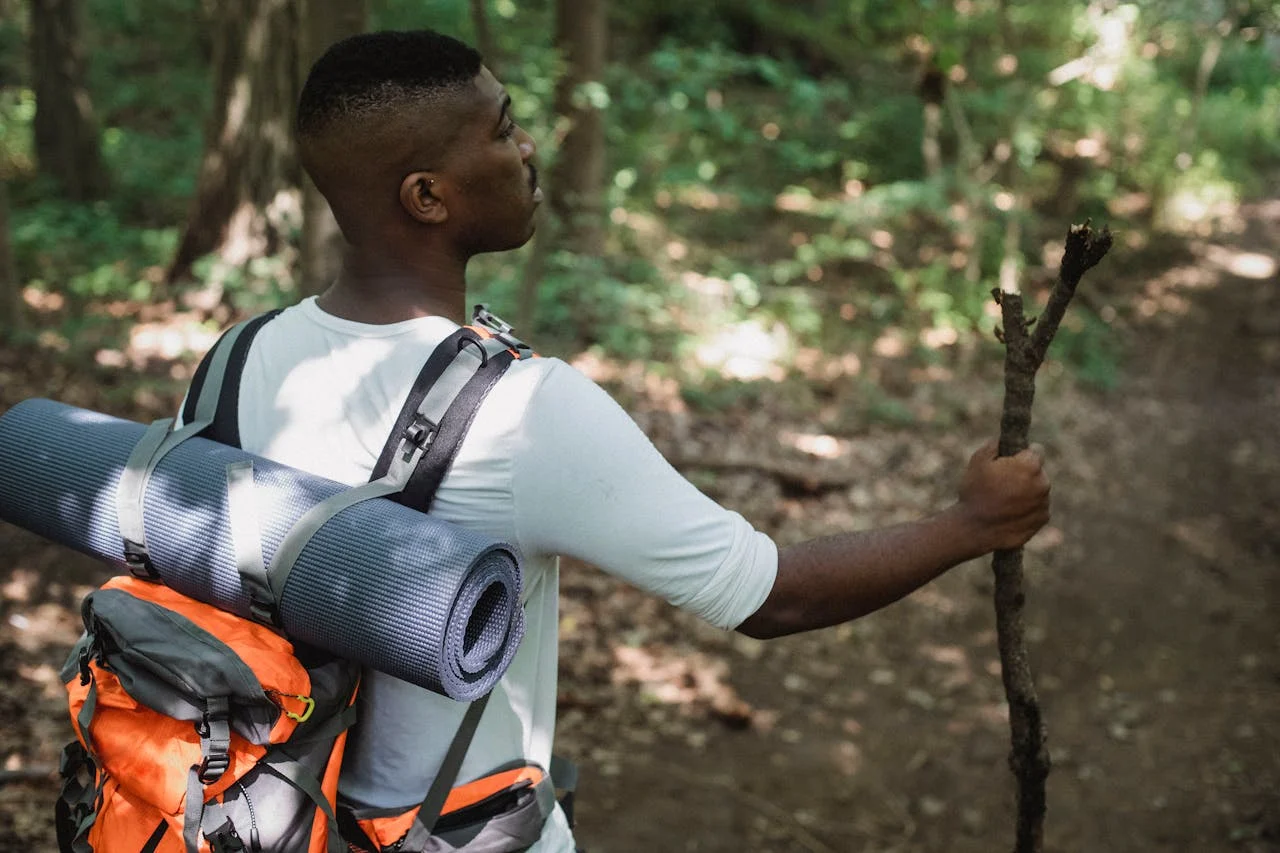Guide to Backpacking in Moab, UT
Planning your next backpacking adventure doesn't have to be overwhelming, especially when you're exploring one of America's most unique desert wilderness environments. Moab, Utah, offers backpacking experiences that range from accessible overnight adventures near spectacular red rock formations to challenging multi-day expeditions through remote canyon systems and high desert wilderness areas that few visitors ever see.
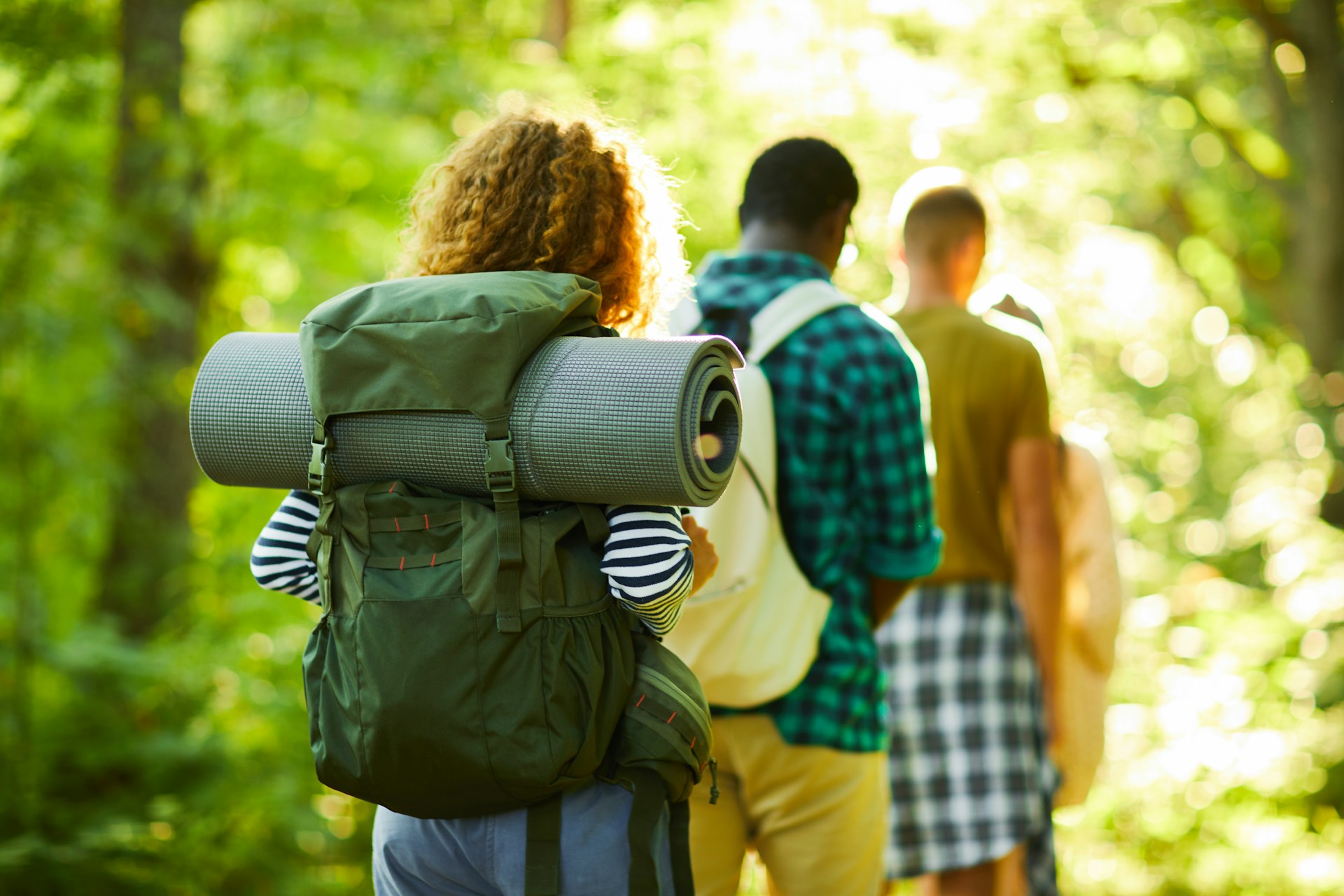
Here's what makes Moab extraordinary for backpacking: you're positioned in the heart of the Colorado Plateau where diverse desert ecosystems, extensive wilderness areas, and spectacular geological formations create backpacking opportunities unlike anywhere else on Earth. With access to Canyonlands National Park's remote Needles and Maze districts offering primitive wilderness camping, Arches National Park providing limited but spectacular backcountry opportunities, BLM wilderness areas containing hundreds of square miles of roadless desert terrain, and the Colorado River corridor offering unique desert river backpacking, Moab serves as the gateway to some of America's most challenging and rewarding desert wilderness experiences.
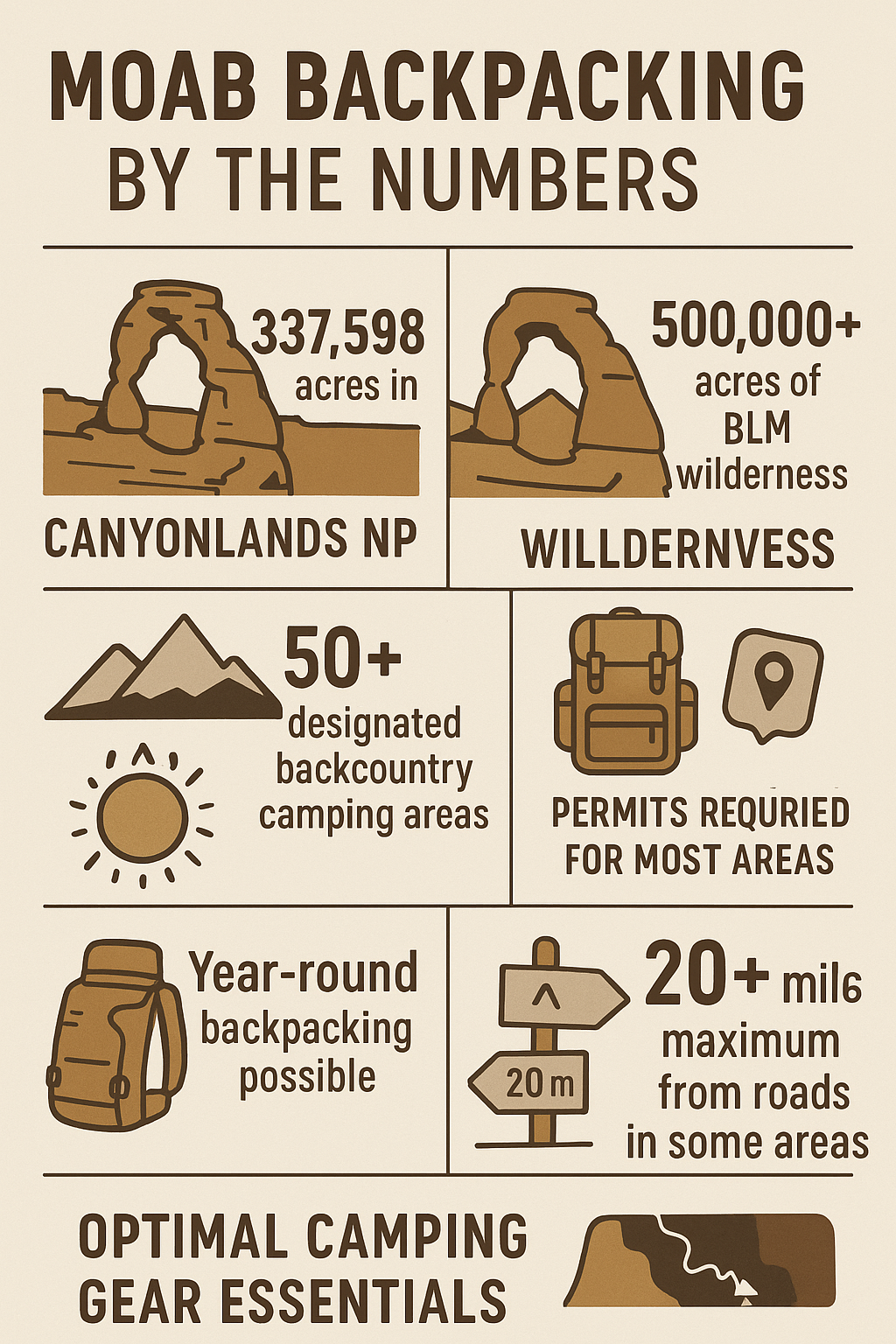
With access to established permit systems in national parks providing managed wilderness experiences, extensive BLM lands offering unlimited exploration opportunities, seasonal water sources requiring careful planning and purification, extreme temperature variations demanding specialized equipment and techniques, and fragile desert ecosystems requiring advanced Leave No Trace skills, Moab backpacking provides some of America's most challenging and rewarding wilderness adventures while demanding respect, preparation, and self-sufficiency appropriate for serious desert environments.
CRITICAL SAFETY NOTICE: Desert backpacking involves serious risks including dehydration, heat illness, hypothermia, flash floods, and potential rescue delays. This environment can be unforgiving to the unprepared. All backpackers must understand and accept these risks while taking full responsibility for their own safety through appropriate training, equipment, and conservative decision-making.
CANYONLANDS NATIONAL PARK: Premier Desert Wilderness
Needles District: Accessible Desert Backpacking
The Needles District provides Canyonlands' most accessible wilderness backpacking opportunities through established trail systems, designated camping areas, and permit systems that support multi-day adventures while maintaining wilderness character and challenge.
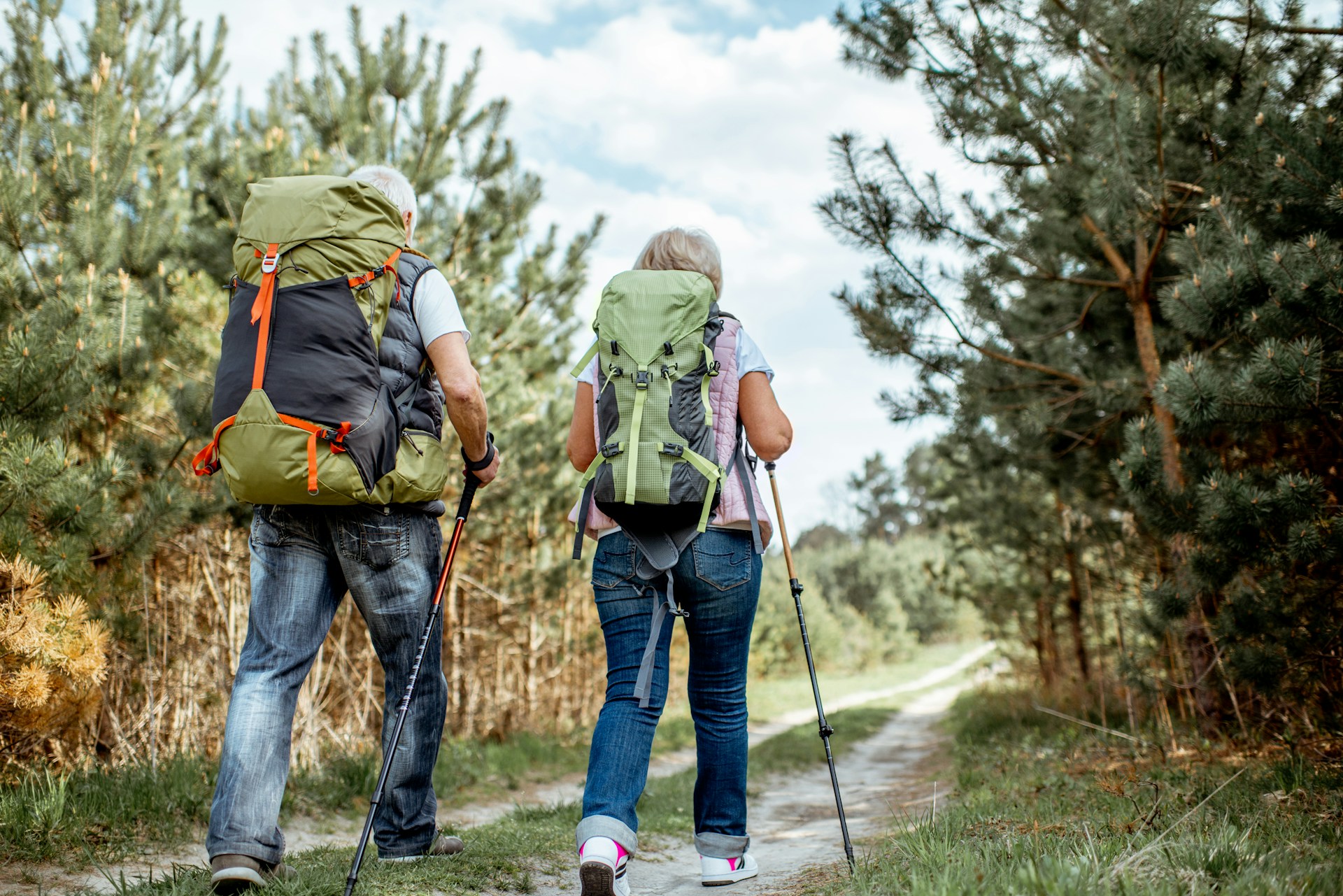
Chesler Park Loop Systems: Multiple loop options ranging from 11-15 miles provide excellent introduction to desert backpacking through spectacular sandstone formations, natural arches, and diverse desert ecosystems. Designated camping areas offer primitive camping with spectacular settings among towering sandstone spires.
The Chesler Park area combines moderate technical difficulty with spectacular scenery while providing established camping areas and escape routes appropriate for developing desert backpacking skills. Water must be carried for entire trips as natural sources are unreliable.
Joint Trail and Druid Arch: This 11-mile round-trip adventure provides access to massive natural arch formations through narrow slot canyon passages and challenging sandstone terrain. The route requires scrambling skills and comfort with primitive trail conditions while providing spectacular wilderness camping opportunities.
Salt Creek and Horse Canyon: Advanced wilderness routes through rugged canyon systems with seasonal water sources and challenging route-finding requirements. These adventures require extensive experience and emergency preparedness for remote wilderness travel where rescue may be impossible.
Needles District Logistics and Planning
Permit Requirements: All backcountry camping requires advance permits with specific campsite reservations and group size limitations. Peak season permits (March through May, September through November) typically book immediately when available.
Water Planning: No reliable water sources exist in most Needles backcountry areas requiring complete self-sufficiency with minimum 1 gallon per person per day plus emergency reserves. Water planning often determines feasible trip lengths and route selection.
Seasonal Considerations: Spring and fall provide optimal conditions while summer requires extreme heat adaptations and winter involves potential extreme cold. Plan timing carefully based on experience level and heat tolerance.
Here's a pro tip: Book Needles permits exactly 5 months in advance when reservations open. Popular sites fill within minutes, so have backup dates and alternative sites ready. Consider weekday trips for better availability.
Maze District: Expert-Only Wilderness
The Maze District represents Canyonlands' most remote and challenging wilderness area, accessible only through high-clearance four-wheel-drive vehicles and requiring advanced desert backpacking skills, complete self-sufficiency, and emergency preparedness for areas where rescue may be impossible.
Land of Standing Rocks: Multi-day wilderness routes through spectacular sandstone formations requiring advanced navigation skills, complete self-sufficiency, and comfort with genuine wilderness travel in areas rarely visited by other humans.
Maze Overlook: Remote camping areas providing spectacular views across canyon systems while requiring advanced four-wheel-drive access and complete wilderness camping self-sufficiency.
Horseshoe Canyon: Detached unit offering spectacular rock art viewing with primitive camping opportunities requiring high-clearance vehicle access and wilderness camping skills.
Maze District Preparation Requirements
Vehicle Requirements: Maze access requires high-clearance four-wheel-drive vehicles with appropriate recovery equipment, spare parts, and mechanical reliability for remote desert travel on primitive roads.
Advanced Skills: Maze backpacking demands advanced wilderness skills including navigation, emergency preparedness, and comfort with complete isolation in challenging environments where outside assistance is unavailable.
Group Self-Sufficiency: Maze adventures require groups capable of handling all emergencies independently including medical situations, vehicle breakdowns, and route-finding challenges without outside assistance.
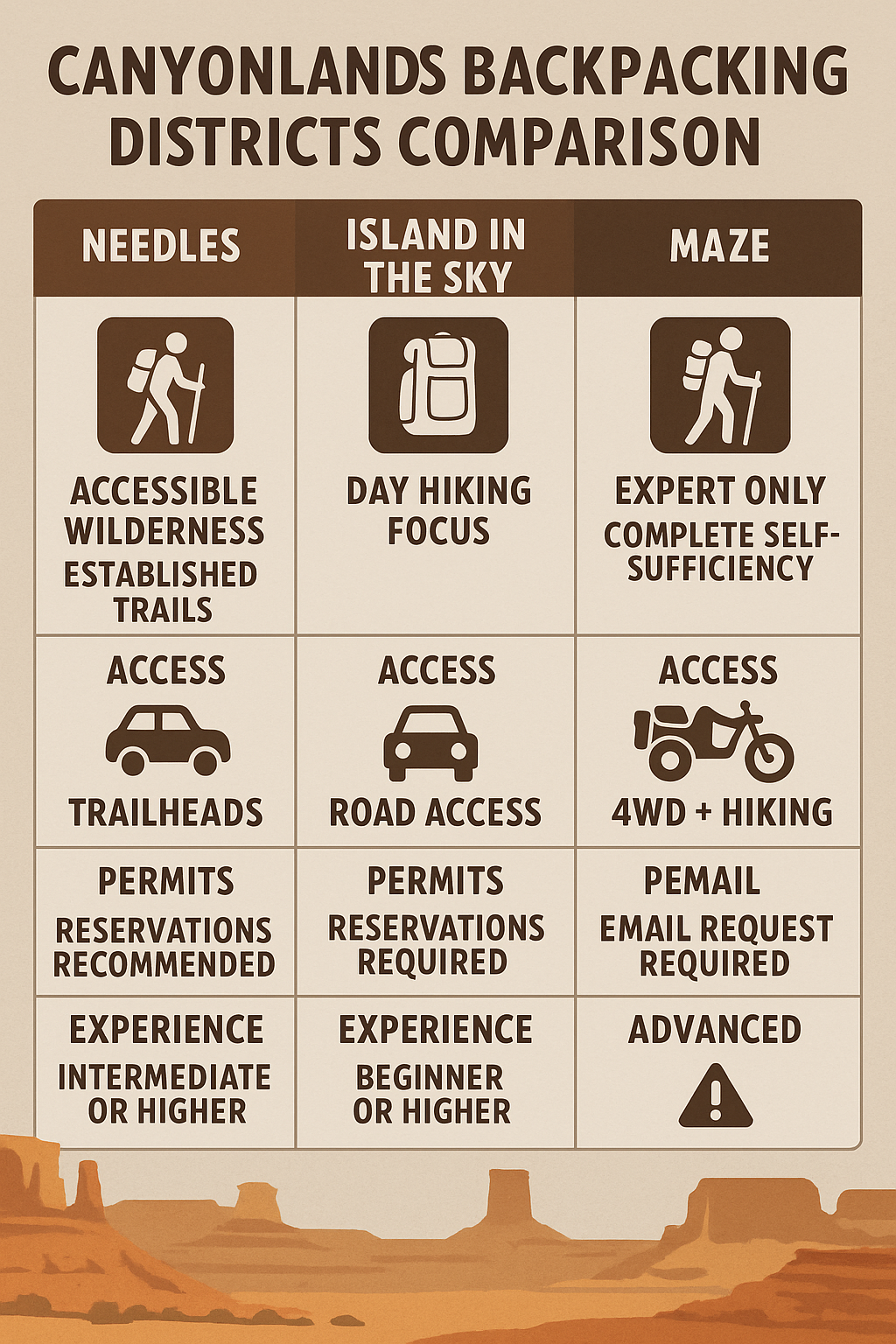
ARCHES NATIONAL PARK: Limited but Spectacular Opportunities
Backcountry Camping Regulations and Areas
Arches National Park offers extremely limited backcountry camping opportunities with strict regulations designed to protect fragile desert ecosystems while providing primitive camping experiences for appropriately prepared and permitted backpackers.
Courthouse Wash: Limited primitive camping opportunities along Courthouse Wash approaches with permits required and strict adherence to Leave No Trace principles. These sites provide access to slot canyon exploration and rock art while maintaining primitive wilderness character.
Klondike Bluffs: Remote camping areas accessible through primitive four-wheel-drive roads with camping opportunities near spectacular sandstone formations and access to primitive hiking areas rarely visited by park visitors.
Devils Garden Extensions: Limited backcountry camping opportunities extending beyond established trail systems with permits required and advanced desert camping skills necessary for safe and legal camping.
Arches Backcountry Regulations
Permit Limitations: Extremely limited permits available with advance reservations required and strict group size limitations designed to minimize impact on fragile desert ecosystems.
Camping Restrictions: Specific camping areas designated with requirements for waste disposal, fire restrictions, and minimal impact techniques appropriate for fragile desert environments.
Access Requirements: Most backcountry areas require high-clearance vehicle access or extended hiking approaches while maintaining strict adherence to established access routes and camping locations.
Equipment and Skills Requirements
Water Self-Sufficiency: Complete water self-sufficiency required as no reliable natural sources exist within park boundaries. Plan minimum 1.5 gallons per person per day for desert conditions.
Waste Management: Complete waste pack-out required including human waste in designated areas. Carry appropriate waste disposal systems and understand regulations for different camping areas.
Navigation Skills: Backcountry areas often lack established trails requiring advanced navigation skills and comfort with cross-country travel in complex desert terrain.
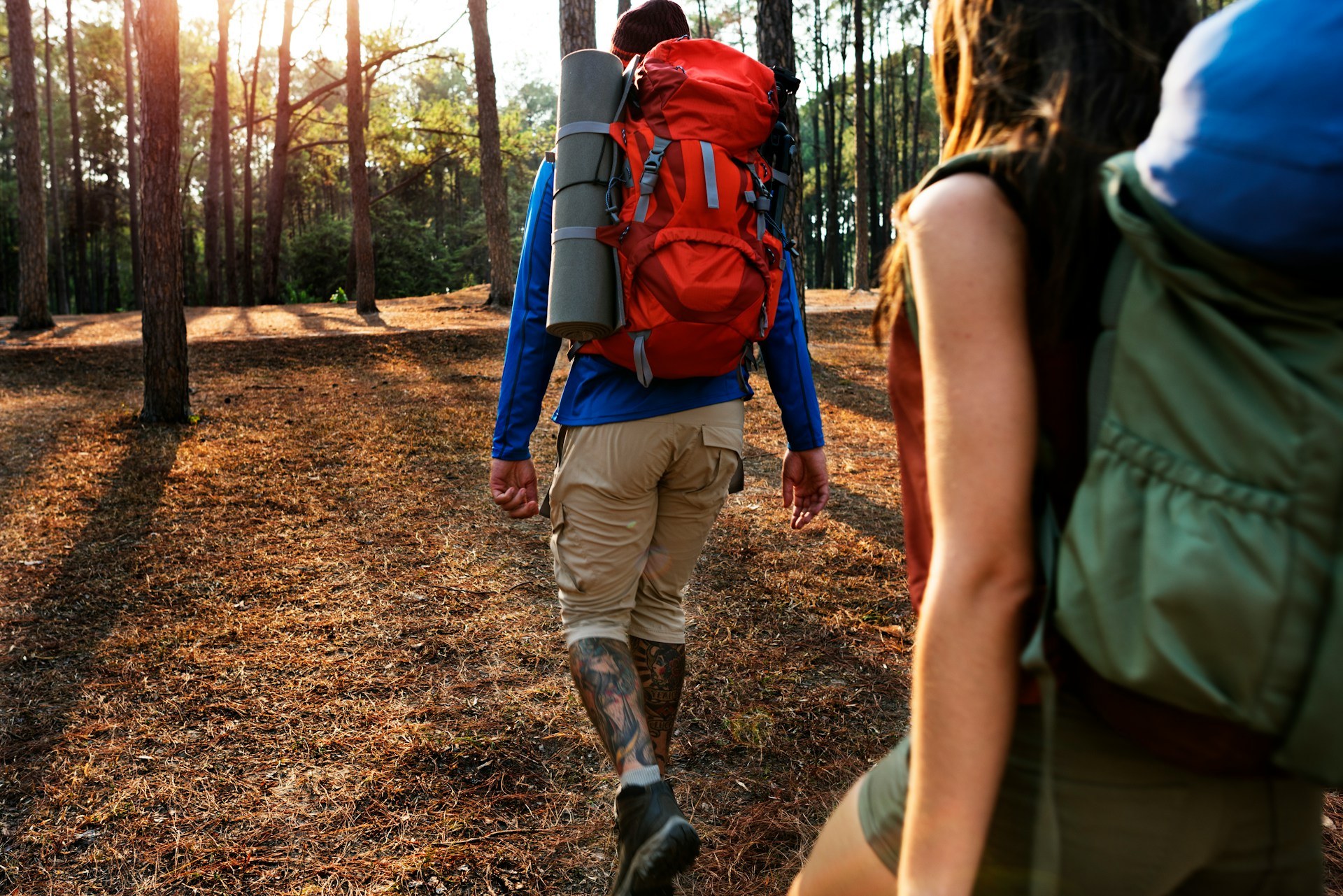
BLM WILDERNESS AREAS: Unlimited Exploration Opportunities
Behind the Rocks Wilderness
This 12,635-acre wilderness area provides diverse backpacking opportunities through slot canyons, sandstone formations, and mesa-top terrain while offering unlimited primitive camping and exploration opportunities beyond established trail systems.
Slot Canyon Systems: Multiple slot canyon systems provide technical backpacking opportunities requiring scrambling skills and comfort with narrow passages while offering spectacular geological formations and primitive camping opportunities.
Mesa-Top Camping: Elevated camping areas provide spectacular views across red rock country while offering different desert ecosystem experiences including grasslands and pinyon-juniper forests.
Cross-Country Exploration: Unlimited exploration opportunities for experienced desert backpackers comfortable with navigation and route-finding in unmarked terrain while respecting wilderness regulations and Leave No Trace principles.
Mill Creek Canyon Wilderness
This 12,169-acre wilderness provides creek corridor backpacking with seasonal water sources, shaded camping opportunities, and different desert ecosystems including riparian vegetation and permanent water features rare in desert environments.
Creek Corridor Camping: Seasonal water sources support extended backpacking adventures though water levels vary significantly with seasons and require purification for safe consumption.
Shaded Canyon Environments: Creek corridors provide shade and cooler temperatures distinct from typical desert backpacking while offering different plant and animal communities adapted to water availability.
Technical Route Sections: Some areas require scrambling skills and comfort with technical terrain while providing access to remote areas rarely visited by other backpackers.
Fisher Towers Area Wilderness
Remote wilderness areas near the famous Fisher Towers provide backpacking opportunities combining spectacular tower views with primitive desert camping and unlimited exploration potential.
Tower Viewpoint Camping: Camping areas providing spectacular views of Fisher Towers formations while maintaining wilderness character and primitive camping requirements.
Desert Ecosystem Diversity: Varied elevations and aspects create diverse desert ecosystems including different plant communities and wildlife habitat supporting extended exploration opportunities.
Primitive Route Finding: Limited established trails require advanced navigation skills and comfort with cross-country travel while providing genuine wilderness experiences and solitude.

BLM Wilderness Regulations and Ethics
Dispersed Camping Rules: Wilderness camping follows Leave No Trace principles with camp placement restrictions designed to minimize environmental impact while protecting fragile desert ecosystems.
Group Size Limitations: Wilderness regulations limit group sizes to minimize impact while maintaining wilderness character and protecting areas from overuse and environmental degradation.
Fire Restrictions: Understand seasonal fire restrictions and wilderness fire policies while carrying alternative cooking and heating systems appropriate for fire restriction periods.
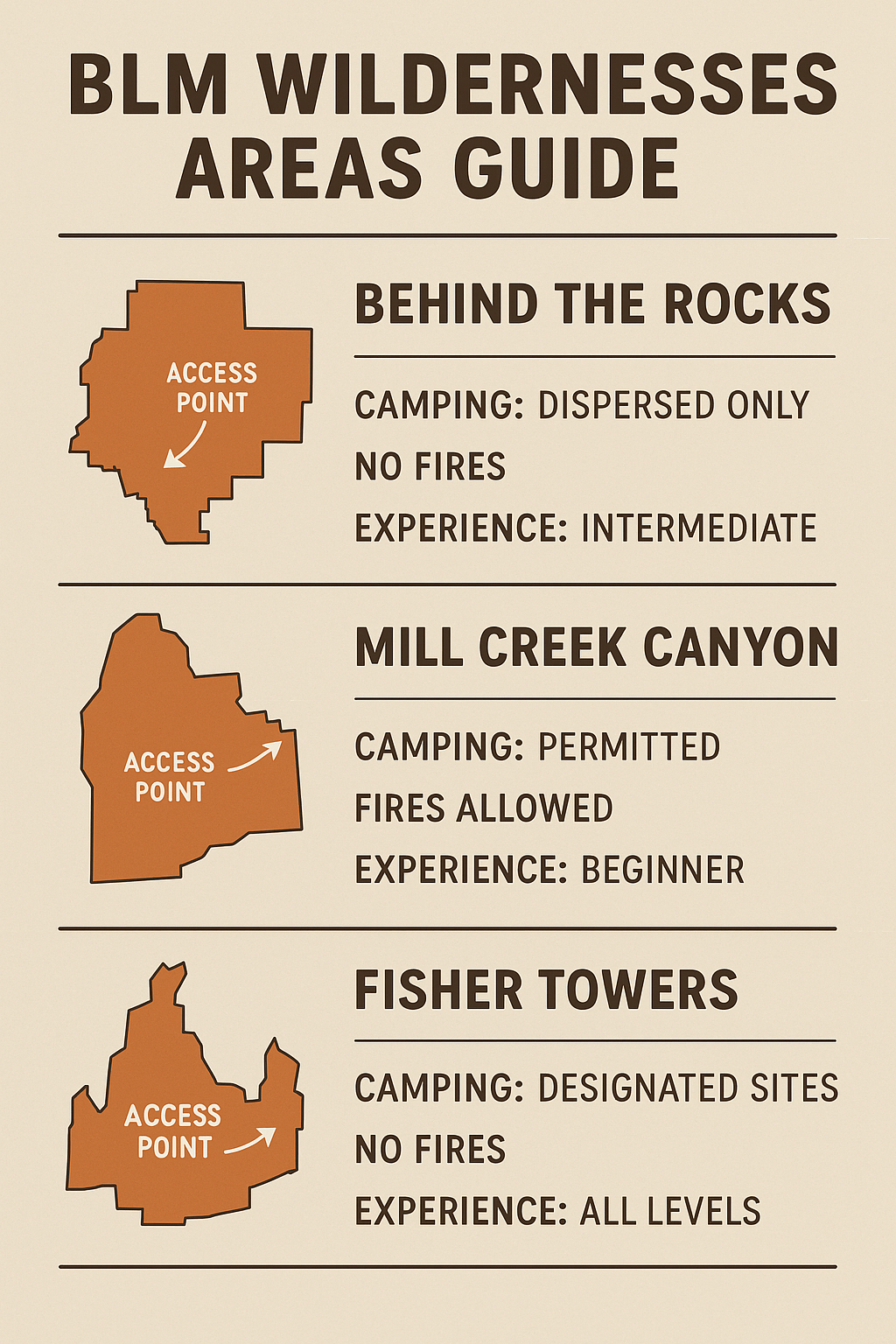
DESERT SURVIVAL SKILLS: Essential Wilderness Competencies
Water Location, Storage, and Purification
Desert backpacking success depends entirely on water management including location of seasonal sources, efficient storage systems, and reliable purification methods while understanding the critical nature of water planning in arid environments.
Seasonal Water Sources: Understanding seasonal water availability in creek systems, potholes, and springs while never relying solely on natural sources and always carrying adequate reserves for complete self-sufficiency.
Water Storage Systems: Efficient water storage including multiple container types, backup storage, and organization systems supporting minimum 1.5 gallons per person per day with emergency reserves for delayed evacuation.
Purification Methods: Multiple purification systems including filters, purification tablets, and boiling capabilities while understanding how different water sources require different treatment approaches.
Conservation Techniques: Water conservation strategies including cooking efficiency, personal hygiene modifications, and equipment cleaning techniques that minimize water consumption while maintaining health and safety.
Navigation and Route Finding
Desert wilderness areas often lack established trails requiring advanced navigation skills including map reading, GPS use, and compass navigation while understanding how desert terrain challenges traditional navigation techniques.
Topographic Map Skills: Advanced map reading including terrain interpretation, elevation assessment, and route planning while understanding how desert features appear on maps versus ground truth.
GPS and Technology: GPS device use including waypoint management, backup power systems, and understanding GPS limitations in canyon environments with limited satellite reception.
Natural Navigation: Understanding natural navigation indicators including sun position, terrain features, and geological formations while developing backup navigation skills for technology failures.
Route Planning: Conservative route planning including escape routes, bailout options, and understanding terrain challenges while planning realistic daily mileages for desert conditions and group capabilities.
Emergency Preparedness and Self-Rescue
Remote desert environments demand comprehensive emergency preparedness including medical skills, self-rescue capabilities, and communication planning for areas where professional rescue may be impossible or significantly delayed.
Medical Emergency Management: Wilderness first aid skills including heat illness treatment, fracture management, and understanding desert-specific medical challenges while carrying comprehensive medical supplies.
Self-Rescue Techniques: Basic self-rescue skills including emergency shelter construction, signaling techniques, and emergency food and water procurement while understanding survival priorities in desert environments.
Communication Planning: Emergency communication including satellite communication devices, emergency signal mirrors, and establishing check-in protocols with reliable contacts for overdue party procedures.
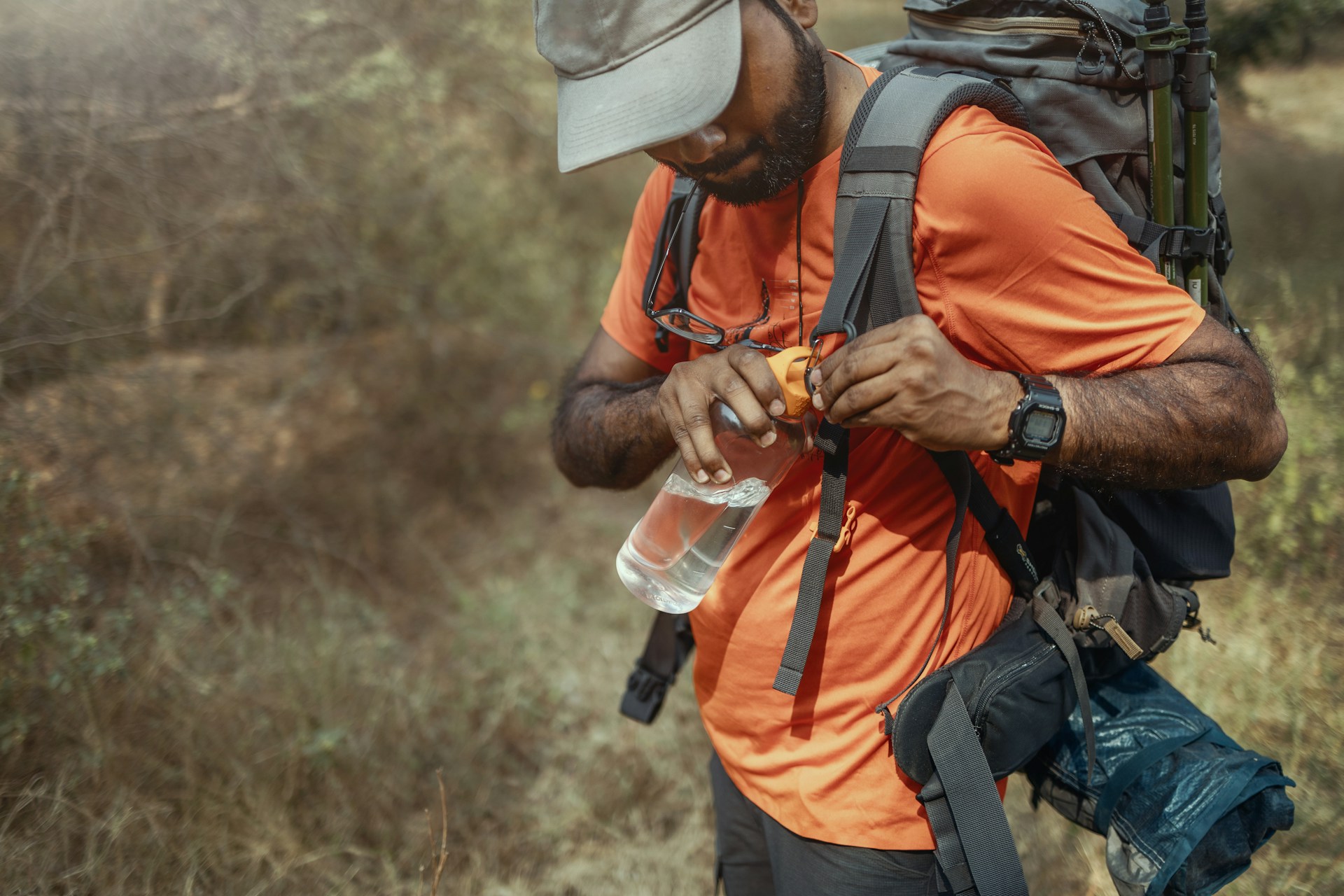
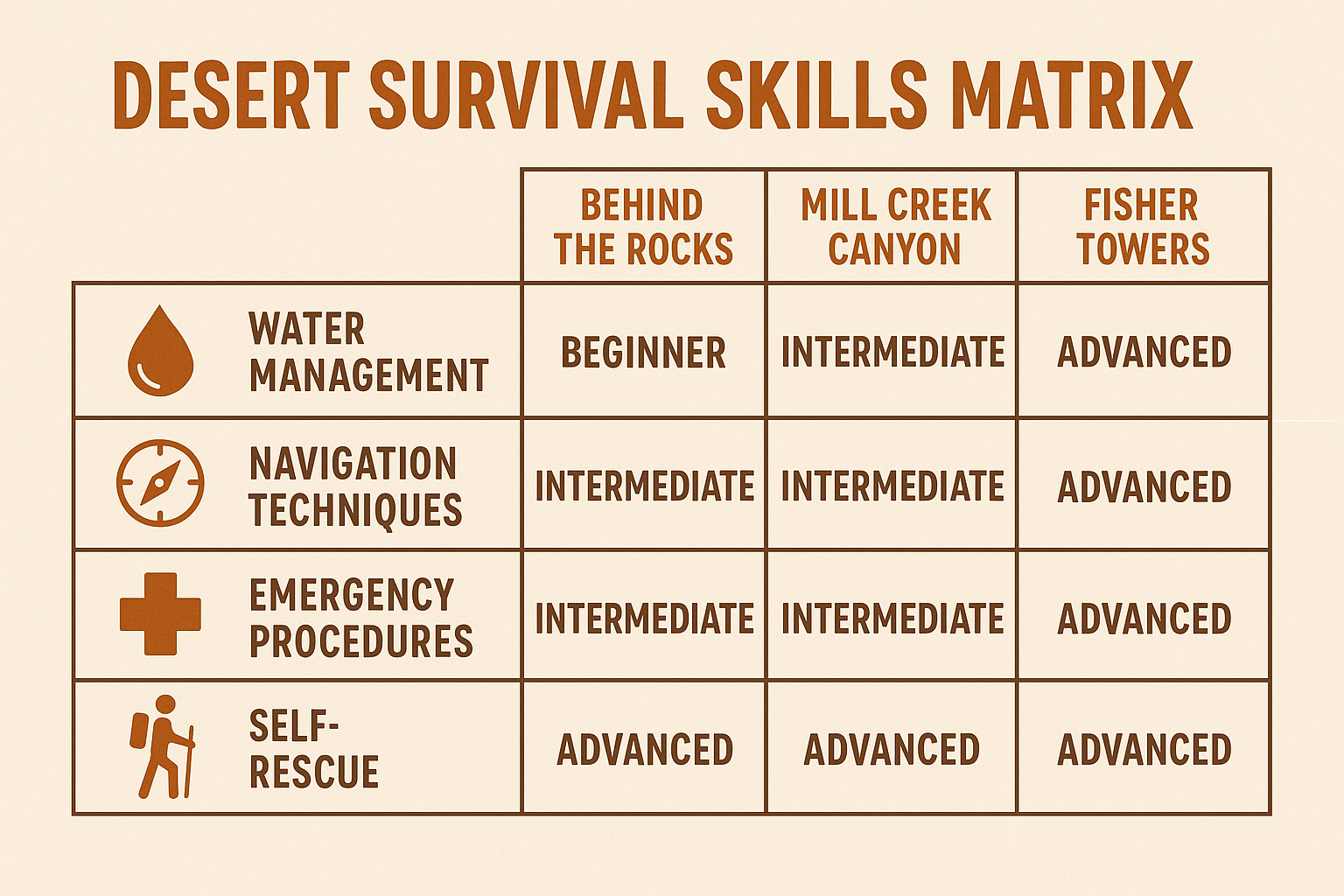
SEASONAL BACKPACKING: Year-Round Desert Challenges
Spring Excellence (March-May)
Spring provides optimal desert backpacking conditions with comfortable temperatures, potential seasonal water sources, and wildflower displays while offering the best balance of temperature comfort and water availability throughout desert wilderness areas.
Temperature Advantages: Spring nighttime temperatures typically range from 40-65°F while daytime highs reach 70-85°F, providing comfortable backpacking conditions without extreme heat or cold adaptation requirements.
Seasonal Water: Spring may provide seasonal water in normally dry creek beds and potholes while never replacing the need for complete water self-sufficiency and careful purification of any natural sources.
Wildflower Displays: Desert wildflower blooms peak in April and May creating spectacular color displays throughout wilderness areas while providing exceptional photography opportunities and botanical education.
Permit Competition: Spring represents peak demand for wilderness permits with reservations required months in advance and immediate booking upon availability for popular areas and dates.
Summer Survival (June-August)
Summer desert backpacking requires extreme adaptations and may be impossible for inexperienced desert backpackers due to life-threatening heat conditions, extreme water requirements, and potential for fatal heat illness.
Extreme Heat Management: Summer temperatures may exceed 110°F during midday with ground temperatures reaching 140°F+. These conditions can be fatal without proper preparation, timing, and heat management strategies.
Water Requirements: Summer conditions may require 2+ gallons per person per day with emergency reserves while understanding that dehydration can quickly become life-threatening in extreme heat conditions.
Timing Requirements: Summer backpacking requires pre-dawn starts with travel completing before 10 AM and resuming after 6 PM when temperatures begin dropping. Midday rest periods become survival requirements rather than preferences.
Route Limitations: Many areas become inaccessible during summer due to extreme conditions while others require specialized experience and equipment inappropriate for most backpackers.
Critical Warning: Summer desert backpacking can be fatal. Only extremely experienced desert backpackers with proven heat management skills should attempt summer wilderness adventures, and even experienced backpackers should consider whether risks outweigh benefits.
Fall Opportunities (September-November)
Fall provides exceptional desert backpacking with comfortable temperatures, stable weather patterns, and optimal conditions for both beginning and advanced desert wilderness adventures.
Optimal Temperature Range: Fall nighttime temperatures range from 35-55°F while daytime highs typically reach 65-85°F, providing excellent backpacking conditions without extreme heat or cold concerns.
Stable Weather: Fall weather tends toward stability with fewer storms and more predictable conditions supporting reliable trip planning and extended wilderness adventures.
Extended Season: Comfortable fall conditions often extend through November providing opportunities for late-season adventures when northern wilderness areas become inaccessible due to snow.
Winter Challenges (December-February)
Winter desert backpacking offers unique opportunities including solitude and different seasonal beauty while requiring specialized cold weather equipment and understanding of desert winter hazards.
Temperature Extremes: Winter nighttime temperatures may drop below 0°F while daytime conditions remain comfortable. These extreme variations require advanced clothing systems and cold weather camping skills.
Weather Risks: Winter storms can bring snow, ice, and extreme cold creating dangerous conditions rapidly while flash flood risks continue during rare winter precipitation events.
Equipment Requirements: Winter desert backpacking requires four-season equipment including cold weather sleeping systems, winter clothing, and understanding how extreme temperature variations affect equipment performance.
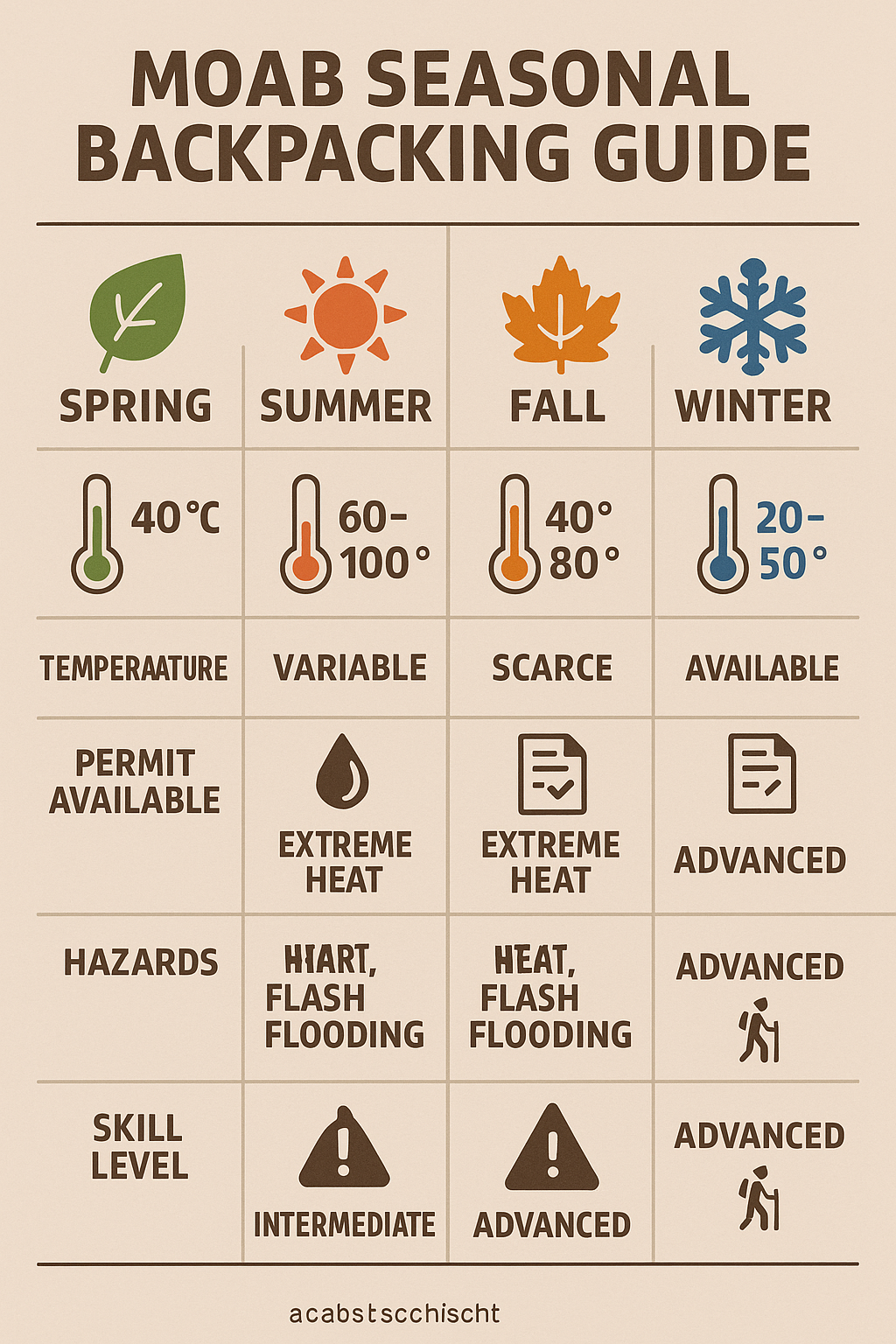
SPECIALIZED EQUIPMENT: Desert Wilderness Gear
Water Storage and Purification Systems
Desert backpacking demands specialized water equipment capable of handling large volumes, multiple purification methods, and reliable performance in extreme conditions while supporting complete water self-sufficiency.
High-Capacity Storage: Multiple water storage options including large capacity containers, backup storage, and organization systems supporting 1.5-2+ gallons per person per day depending on conditions and trip length.
Multiple Purification Methods: Redundant purification systems including filters appropriate for turbid desert water, purification tablets for backup, and boiling capabilities for emergency purification when other methods fail.
Insulation and Protection: Water storage insulation preventing freezing during cold nights while protecting storage systems from extreme temperature variations and UV degradation common in desert environments.
Shelter Systems for Extreme Conditions
Desert environments create extreme shelter challenges including temperature variations exceeding 60°F, high winds, intense UV exposure, and potential flash flood risks requiring specialized shelter selection and setup techniques.
Four-Season Capability: Shelter systems capable of handling extreme temperature variations, high winds, and potential precipitation while providing adequate ventilation for temperature management and condensation control.
UV Protection: Extended UV exposure degrades tent materials rapidly requiring UV-resistant materials or additional protection while understanding how intense desert sun affects equipment longevity and performance.
Wind Resistance: Desert winds can be extreme requiring shelter systems capable of handling sustained high winds while understanding proper setup techniques and site selection for wind protection.
Specialized Desert Clothing Systems
Layering for Extremes: Clothing systems capable of handling temperature variations from below freezing to over 100°F while providing sun protection, moisture management, and adaptability for changing conditions.
Sun Protection Priority: Comprehensive sun protection including long sleeves, pants, wide-brimmed hats, and neck protection while understanding how intense desert UV affects skin safety and heat management.
Footwear Systems: Sturdy hiking boots for technical terrain combined with camp shoes for comfort while considering gaiters for sand and debris protection during extended desert hiking.
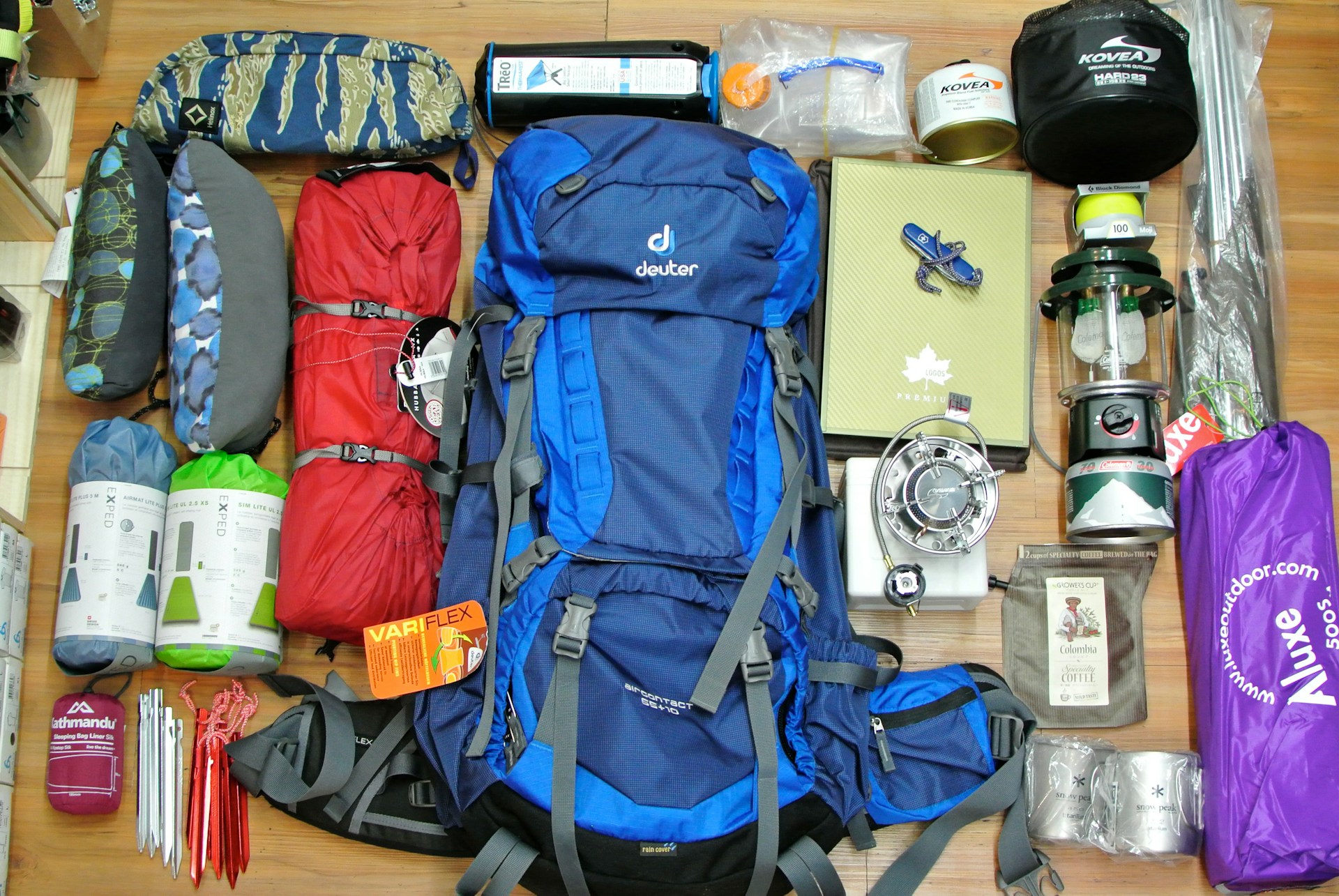
Navigation and Emergency Equipment
Comprehensive Navigation: GPS devices with extra batteries, detailed topographic maps, compass, and backup navigation methods while understanding desert navigation challenges and technology limitations.
Emergency Communication: Satellite communication devices providing emergency rescue capabilities for areas without cell coverage while understanding communication protocols and emergency procedures.
Emergency Shelter and Signaling: Emergency shelter systems, signaling devices, and emergency supplies providing survival capabilities for unexpected emergencies or rescue delays in remote areas.
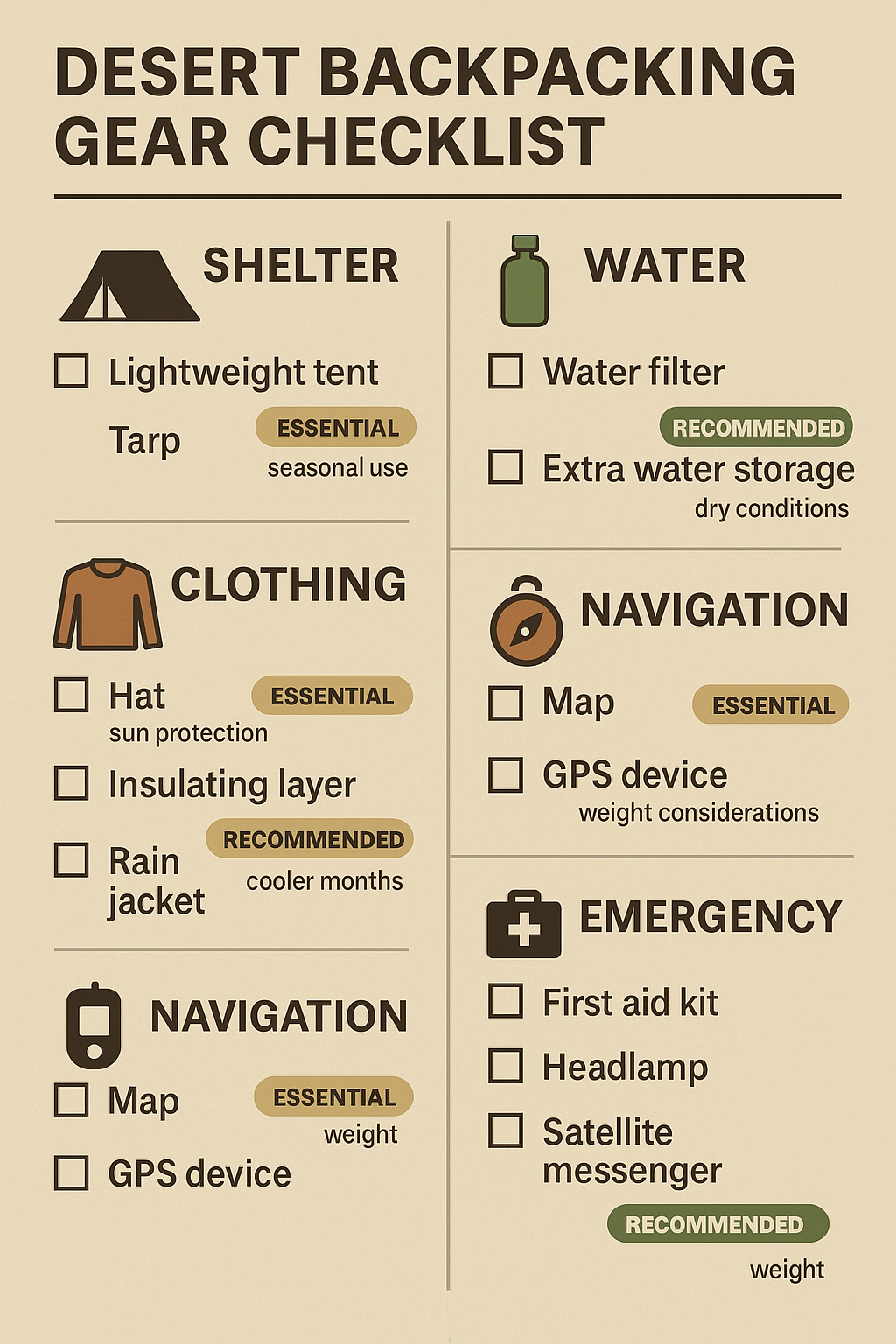
FOOD PLANNING AND NUTRITION: Desert Dietary Requirements
Caloric and Nutritional Needs
Desert backpacking creates increased caloric requirements due to temperature regulation demands, physical challenges of desert terrain, and stress of extreme environmental conditions while requiring careful meal planning for weight and preparation constraints.
Increased Caloric Demands: Desert conditions may increase daily caloric requirements to 4,000+ calories per person per day while considering how extreme temperatures affect energy expenditure and nutritional needs.
Electrolyte Management: Critical electrolyte replacement requirements due to increased sweating and heat stress while understanding signs of electrolyte imbalance and appropriate replacement strategies.
Protein and Recovery: Adequate protein intake supporting muscle recovery and maintenance during challenging physical conditions while considering protein sources appropriate for desert cooking limitations.
Food Storage and Preparation
Temperature Protection: Food storage protecting against extreme temperature variations while preventing spoilage and maintaining food safety in conditions ranging from below freezing to over 100°F.
Water-Efficient Cooking: Meal planning minimizing water requirements for preparation while maximizing nutrition and satisfaction within water conservation constraints essential for desert survival.
Lightweight Nutrition: Food selection balancing weight considerations with nutritional density while understanding how extended desert backpacking affects appetite and dietary needs.
Special Dietary Considerations
Heat Appetite Suppression: Understanding how extreme heat affects appetite while ensuring adequate nutrition intake even when normal eating patterns are disrupted by environmental stress.
Cold Weather Needs: Winter desert backpacking may require increased caloric intake for temperature regulation while considering how cold affects food preparation and storage.
Emergency Food Supplies: Emergency food reserves appropriate for extended trips or emergency situations while considering shelf stability and preparation requirements in survival scenarios.

ROUTE PLANNING AND LOGISTICS: Desert Expedition Management
Advanced Trip Planning
Desert backpacking requires comprehensive trip planning including detailed route research, permit coordination, and logistics management while understanding how desert conditions affect all aspects of expedition planning and safety.
Detailed Route Research: Comprehensive route information including water sources, camping areas, escape routes, and seasonal considerations while understanding how conditions change throughout the year and recent reports from other parties.
Permit Coordination: Complex permit systems requiring advance planning, reservation timing, and understanding of different agency requirements while coordinating permits for multi-area trips crossing different jurisdictions.
Logistics Management: Transportation, resupply, and equipment logistics including vehicle access, parking, and gear staging while considering how remote access affects trip planning and emergency preparedness.
Risk Assessment and Contingency Planning
Comprehensive Risk Analysis: Systematic risk assessment including group capabilities, route difficulty, seasonal conditions, and emergency resources while understanding how risks compound in desert environments.
Contingency Planning: Multiple backup plans including route alternatives, weather delays, and emergency procedures while understanding how changing conditions affect safety and trip success.
Group Management: Advanced group leadership including decision-making protocols, skill assessment, and safety management while maintaining group cohesion and morale during challenging conditions.
Communication and Emergency Protocols
Check-In Procedures: Detailed communication plans with reliable contacts including overdue procedures and emergency contact information while ensuring someone reliable knows exact itinerary and timing expectations.
Emergency Resources: Understanding rescue resources and limitations while preparing for scenarios where outside assistance may be delayed or impossible requiring complete self-sufficiency.
Documentation: Detailed trip documentation including route descriptions, participant information, and emergency contact data while ensuring appropriate people have complete information for emergency response.
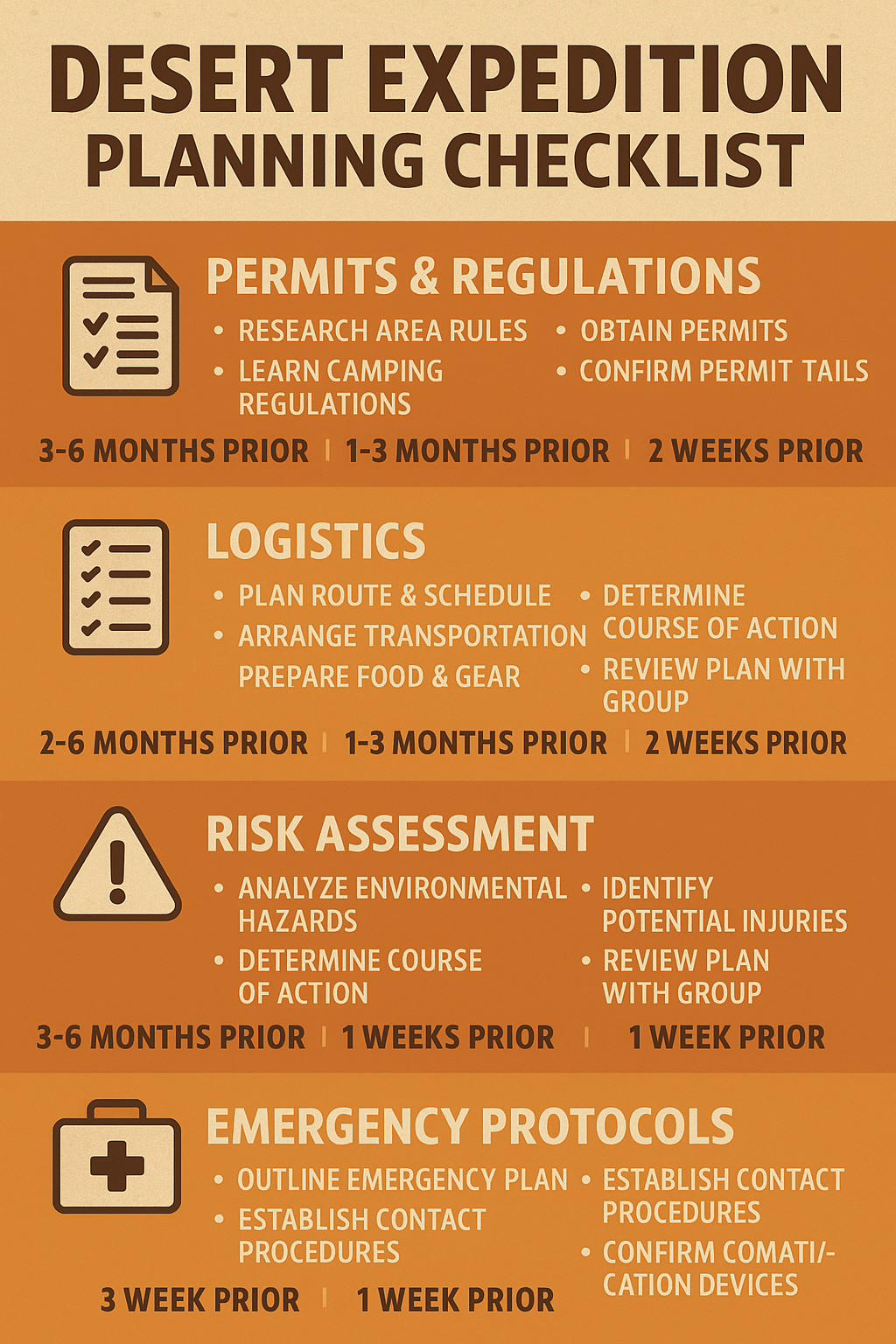
CONSERVATION AND WILDERNESS ETHICS: Protecting Desert Ecosystems
Advanced Leave No Trace Practices
Desert environments require the highest level of Leave No Trace adherence due to fragile ecosystems, slow recovery rates, and permanent impact potential while understanding how desert conditions affect traditional Leave No Trace applications.
Surface Impact Management: Understanding biological soil crusts, vegetation fragility, and appropriate travel techniques while minimizing surface impacts that can persist for decades in desert environments.
Waste Management Excellence: Complete waste pack-out including human waste in sensitive areas while understanding appropriate waste disposal techniques for different desert environments and regulations.
Water Source Protection: Critical protection of rare water sources from contamination while maintaining appropriate distances and understanding how limited water affects desert ecosystems.
Wildlife and Habitat Protection
Desert Wildlife Respect: Understanding desert wildlife including behavioral patterns, habitat needs, and human impact while maintaining appropriate distances and minimizing disturbance to species adapted to extreme environments.
Seasonal Sensitivity: Understanding breeding seasons, migration patterns, and critical habitat periods while planning trips to minimize wildlife disturbance during sensitive periods.
Ecosystem Protection: Protecting fragile desert plant communities including cryptobiotic soil, rare plant populations, and understanding how human activities affect ecosystem health and stability.
Cultural Resource Protection
Archaeological Site Respect: Understanding and protecting abundant archaeological sites throughout Moab area while maintaining legal and ethical obligations to preserve cultural heritage for future generations.
Rock Art Protection: Proper behavior around petroglyphs and pictographs while understanding legal protections and cultural significance of rock art sites throughout the region.
Sacred Site Awareness: Respecting sites of cultural and spiritual significance to Native American tribes while understanding cultural protocols and access restrictions.
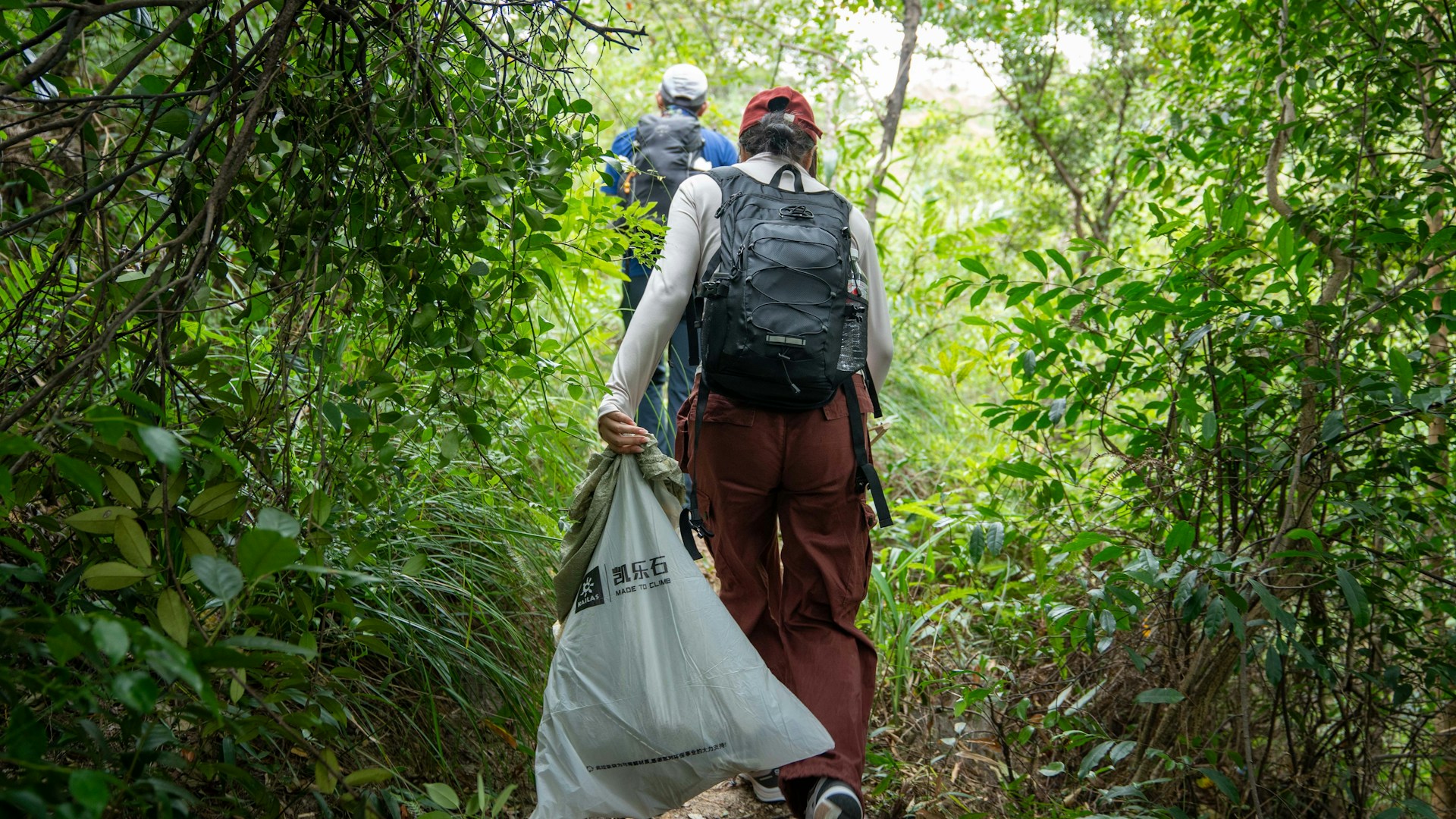
EMERGENCY SCENARIOS AND RESCUE: Desert Crisis Management
Common Desert Emergencies
Desert backpacking involves specific emergency scenarios requiring specialized knowledge and response techniques while understanding how desert conditions affect emergency management and rescue operations.
Heat-Related Illness: Recognition and treatment of heat exhaustion and heat stroke while understanding prevention techniques and emergency cooling methods appropriate for desert conditions.
Dehydration and Electrolyte Imbalance: Understanding stages of dehydration, electrolyte imbalance symptoms, and treatment protocols while recognizing when evacuation becomes necessary.
Hypothermia in Desert: Understanding how desert temperature variations cause hypothermia while recognizing symptoms and treatment appropriate for desert conditions with limited resources.
Flash Flood Response: Understanding flash flood risks, escape procedures, and survival techniques while recognizing weather patterns and terrain features that create flood hazards.
Self-Rescue and Group Rescue
Technical Self-Rescue: Basic technical rescue skills including rappelling, hauling, and evacuation techniques appropriate for desert terrain while understanding equipment requirements and safety considerations.
Medical Emergency Management: Advanced wilderness first aid including patient assessment, treatment priorities, and evacuation decision-making while understanding how desert conditions affect medical emergencies.
Group Emergency Management: Leadership and decision-making during emergencies while maintaining group safety and coordinating rescue efforts in remote locations.
Communication and Rescue Coordination
Emergency Communication: Effective use of satellite communication devices while understanding proper emergency protocols and information requirements for rescue coordination.
Rescue Resource Understanding: Knowledge of available rescue resources including helicopter capabilities, ground rescue limitations, and realistic rescue timelines for different areas.
Self-Evacuation Planning: Understanding when self-evacuation is appropriate versus waiting for rescue while assessing group capabilities and risk factors.
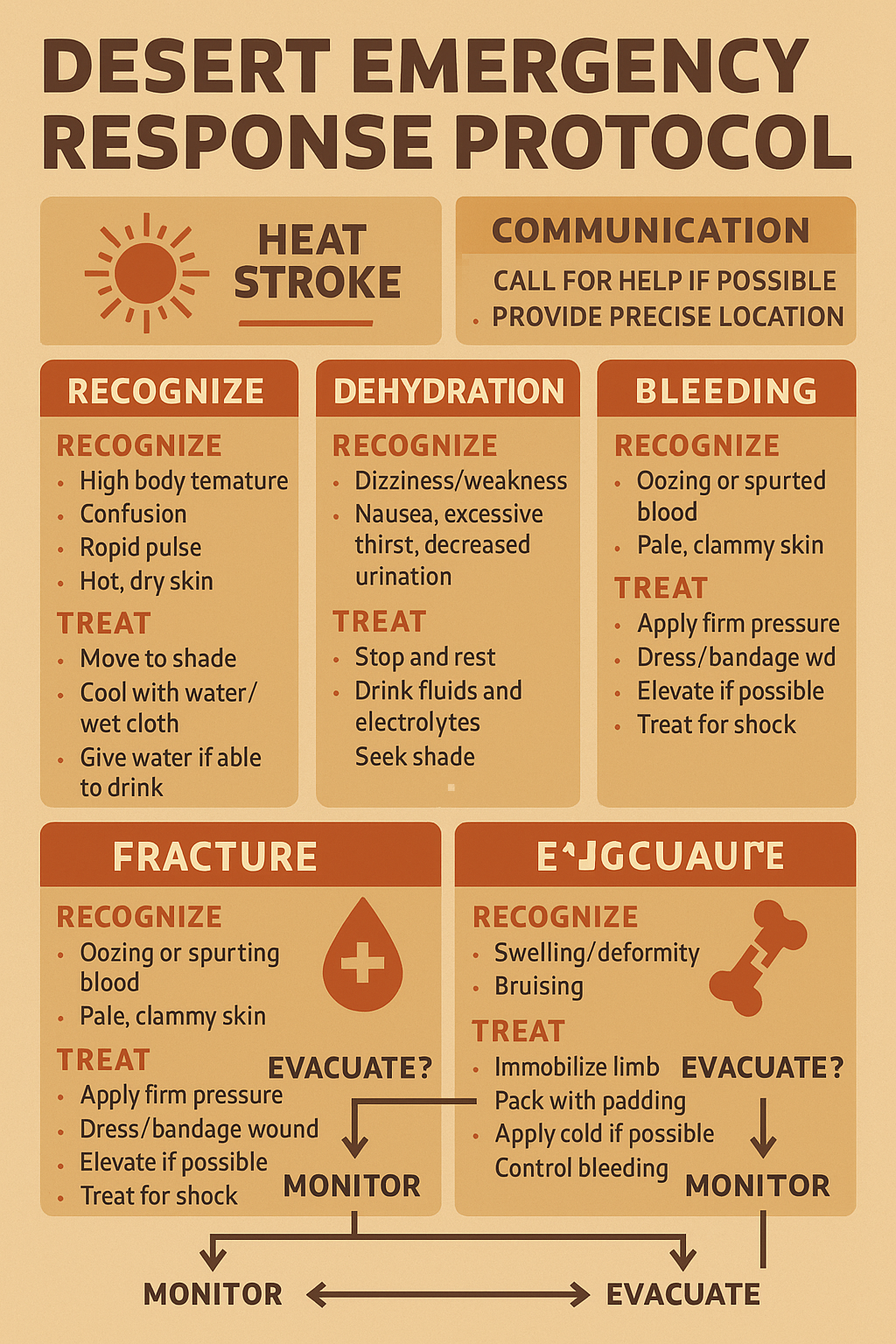
ADVANCED DESERT BACKPACKING: Expert-Level Adventures
Technical Route Finding
Advanced desert backpacking often involves route finding through unmarked terrain requiring sophisticated navigation skills and understanding of desert travel techniques while maintaining safety margins in challenging environments.
Cross-Country Navigation: Advanced techniques for travel across unmarked terrain including terrain association, GPS techniques, and understanding how desert features affect navigation while maintaining course accuracy.
Canyon Systems: Understanding canyon navigation including flood hazards, escape route identification, and technical terrain negotiation while assessing risks and group capabilities.
Remote Area Access: Planning and executing access to remote areas requiring advanced logistics, self-sufficiency, and emergency preparedness while understanding isolation risks and rescue limitations.
Extended Expeditions
Multi-week desert expeditions require advanced planning, logistics, and wilderness skills while understanding how extended exposure to desert conditions affects group dynamics and individual performance.
Resupply Planning: Advanced logistics including food caches, water resupply, and equipment replacement while understanding desert storage challenges and long-term planning requirements.
Extended Group Dynamics: Understanding how extended desert exposure affects group relationships, decision-making, and leadership while maintaining group cohesion and safety throughout challenging expeditions.
Equipment Systems: Advanced equipment selection and maintenance for extended desert exposure while understanding how extreme conditions affect equipment reliability and replacement needs.
Specialized Desert Environments
Slot Canyon Systems: Technical slot canyon navigation requiring specialized skills, equipment, and understanding of flood hazards while assessing technical difficulty and escape options.
High Desert Alpine: Combining desert and alpine conditions including snow travel, technical terrain, and extreme temperature variations while understanding specialized equipment and technique requirements.
River Canyon Integration: Combining desert backpacking with river travel requiring specialized skills, equipment, and understanding of integrated land-water wilderness travel.
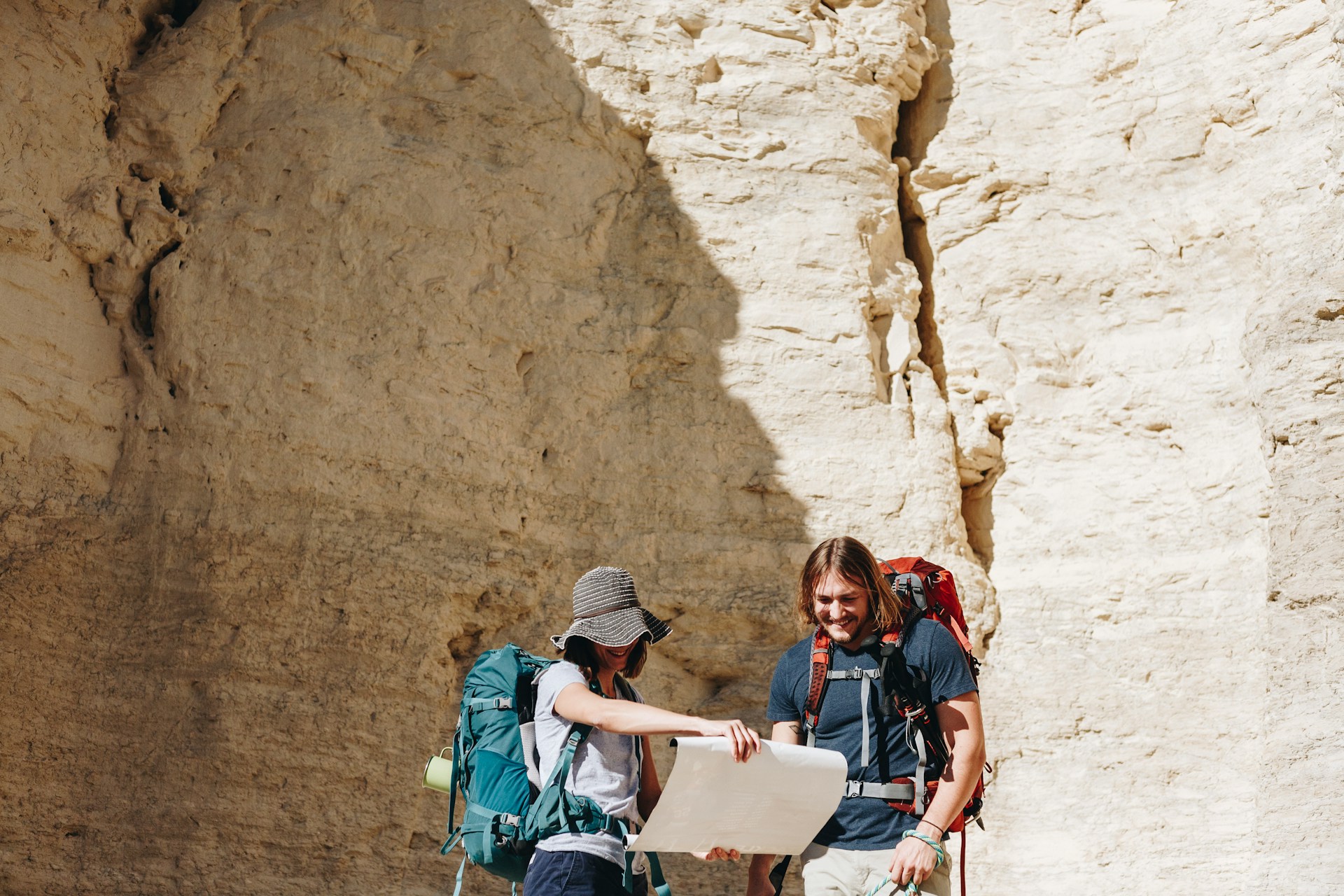
PLANNING YOUR MOAB BACKPACKING ADVENTURE
Comprehensive Preparation Assessment
Honest Skill Evaluation: Critical assessment of wilderness skills, desert experience, and group capabilities while understanding how desert environments amplify consequences of poor preparation or decision-making.
Physical Preparation: Comprehensive fitness preparation including cardiovascular conditioning, load carrying, and heat adaptation while understanding physical demands of desert wilderness travel.
Equipment Investment: Understanding specialized equipment requirements and costs while considering rental options and gradual equipment acquisition for developing desert backpacking capabilities.
Route Selection and Progression
Appropriate Challenge Selection: Choosing objectives appropriate for current skill levels while providing reasonable progression challenges without exceeding safety margins or group capabilities.
Seasonal Timing: Understanding optimal timing for different objectives while balancing weather conditions, permit availability, and personal schedule constraints.
Backup Planning: Comprehensive alternative planning including route options, weather contingencies, and group capability changes while maintaining flexibility for changing conditions.
Risk Management and Decision Making
Conservative Planning: Understanding how desert environments require more conservative planning margins while balancing adventure goals with appropriate safety considerations.
Group Compatibility: Ensuring group members share similar risk tolerance, skill levels, and commitment to safety while understanding how group dynamics affect desert wilderness safety.
Emergency Preparedness: Comprehensive emergency planning appropriate for specific objectives while understanding rescue limitations and self-sufficiency requirements.
Understanding Moab's backpacking opportunities within the context of desert wilderness challenges helps backpackers appreciate both the spectacular experiences available and the serious responsibilities required for safety and environmental protection. The skills, judgment, and environmental awareness developed through desert backpacking provide foundation for wilderness travel throughout the world while contributing to conservation and stewardship of these unique and fragile landscapes.
FINAL SAFETY REMINDER: Desert backpacking involves serious risks that can be fatal. Extreme heat, extreme cold, dehydration, flash floods, and remoteness create hazards that demand respect and preparation. This guide provides general information only and cannot replace proper instruction, experience, and sound judgment. All backpackers must understand and accept these risks while taking full responsibility for their own safety through appropriate training, equipment, and conservative decision-making.
